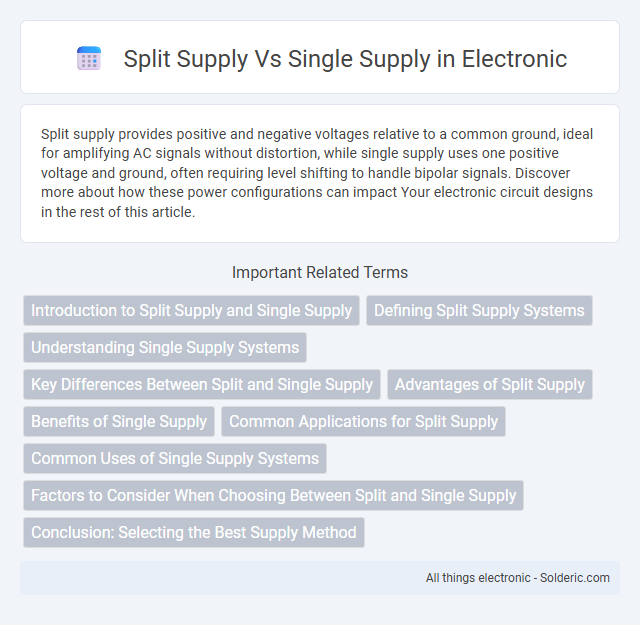Split supply provides positive and negative voltages relative to a common ground, ideal for amplifying AC signals without distortion, while single supply uses one positive voltage and ground, often requiring level shifting to handle bipolar signals. Discover more about how these power configurations can impact Your electronic circuit designs in the rest of this article.
Comparison Table
| Aspect | Split Supply | Single Supply |
|---|---|---|
| Voltage Rails | Positive and Negative voltage (e.g., +-15V) | Single positive voltage (e.g., +5V or +12V) plus ground |
| Signal Swing | Centered at 0V, allowing symmetrical swing | Shifted above ground, limited negative swing |
| Complexity | More complex power supply design | Simpler power supply design |
| Cost | Potentially higher due to dual rails | Generally lower cost |
| Common Applications | Operational amplifiers, analog signal processing | Digital circuits, battery-powered devices |
| Ground Reference | Ground at zero potential between rails | Ground as the 0V reference, supply above ground |
| Design Flexibility | Allows bipolar signal handling | Limited to unipolar signals |
Introduction to Split Supply and Single Supply
Split supply provides both positive and negative voltages relative to a common ground, enabling circuits to handle bipolar signals and improve linearity in analog applications. Single supply offers a single positive voltage referenced to ground, simplifying design and power consumption but often requiring level shifting for bipolar signal processing. Understanding these supply types is crucial for selecting appropriate power sources in operational amplifiers and other analog systems.
Defining Split Supply Systems
Split supply systems provide both positive and negative voltage rails, typically +-12V or +-15V, essential for powering analog circuits that require bipolar voltage inputs. Unlike single supply systems, which supply only a positive voltage relative to ground, split supplies enable circuits to handle signals that swing above and below zero volts. This dual voltage configuration improves signal linearity and headroom in operational amplifiers, analog sensors, and audio equipment.
Understanding Single Supply Systems
Single supply systems operate using one voltage source, typically referenced to ground, simplifying circuit design by reducing the number of power rails required. They often rely on virtual ground or biasing techniques to allow signals to swing above and below a reference point within the single supply voltage range. Understanding single supply operation is crucial for designing low-voltage analog circuits, especially in battery-powered applications where efficiency and simplicity are paramount.
Key Differences Between Split and Single Supply
Split supply provides both positive and negative voltage rails, enabling your circuits to handle bipolar signals with greater ease, while single supply systems operate with only one positive voltage rail and ground. This fundamental difference impacts circuit design, noise performance, and the type of components used, as split supplies allow symmetric operation whereas single supplies require level shifting or virtual grounds. Choosing between split and single supply depends on your application's voltage range requirements and complexity, affecting overall efficiency and signal fidelity.
Advantages of Split Supply
Split supply offers enhanced signal integrity by providing both positive and negative voltage rails, enabling operational amplifiers and analog circuits to handle bipolar signals effectively without distortion. It reduces the need for level-shifting components, simplifying circuit design and improving dynamic range. This power configuration is essential in applications requiring precise and symmetrical voltage swings, such as audio processing and instrumentation amplifiers.
Benefits of Single Supply
Single supply power systems simplify circuit design by reducing the need for dual power sources, thereby lowering costs and enhancing efficiency. They enable easier integration with modern semiconductor devices that often operate on a single voltage rail, improving overall system reliability. Using a single supply also minimizes power consumption and reduces electromagnetic interference in compact electronic applications.
Common Applications for Split Supply
Split supply power sources are commonly used in operational amplifiers, audio equipment, and analog signal processing circuits where both positive and negative voltage rails are necessary for proper signal amplification and symmetrical waveform generation. This configuration supports devices like instrumentation amplifiers and audio mixers that require dual voltages for accurate and balanced output. Your choice of split supply ensures improved signal integrity and reduces distortion in sensitive analog applications.
Common Uses of Single Supply Systems
Single supply systems are commonly used in battery-powered devices, portable electronics, and low-power microcontroller applications where simplicity and reduced component count are essential. These systems operate from a single voltage rail, typically 3.3V or 5V, making them ideal for consumer gadgets, handheld instruments, and embedded systems. Their design supports cost-effective implementation while ensuring compatibility with digital logic and analog-to-digital converters.
Factors to Consider When Choosing Between Split and Single Supply
Choosing between split supply and single supply depends on your circuit's voltage requirements, complexity, and power efficiency. Split supply systems offer symmetrical voltages, ideal for analog signal processing and reducing noise, while single supply designs simplify power management and are better suited for low-voltage, battery-powered applications. Assess your device's operational voltage range, noise sensitivity, and space constraints to determine the optimal power configuration for your project.
Conclusion: Selecting the Best Supply Method
Choosing between split supply and single supply depends on your specific circuit requirements and operational constraints. Split supply offers dual voltage rails, enhancing signal stability and reducing distortion in analog and audio applications. Single supply is simpler, more cost-effective, and suitable for low-power digital circuits where dual voltage is unnecessary.
split supply vs single supply Infographic

 solderic.com
solderic.com